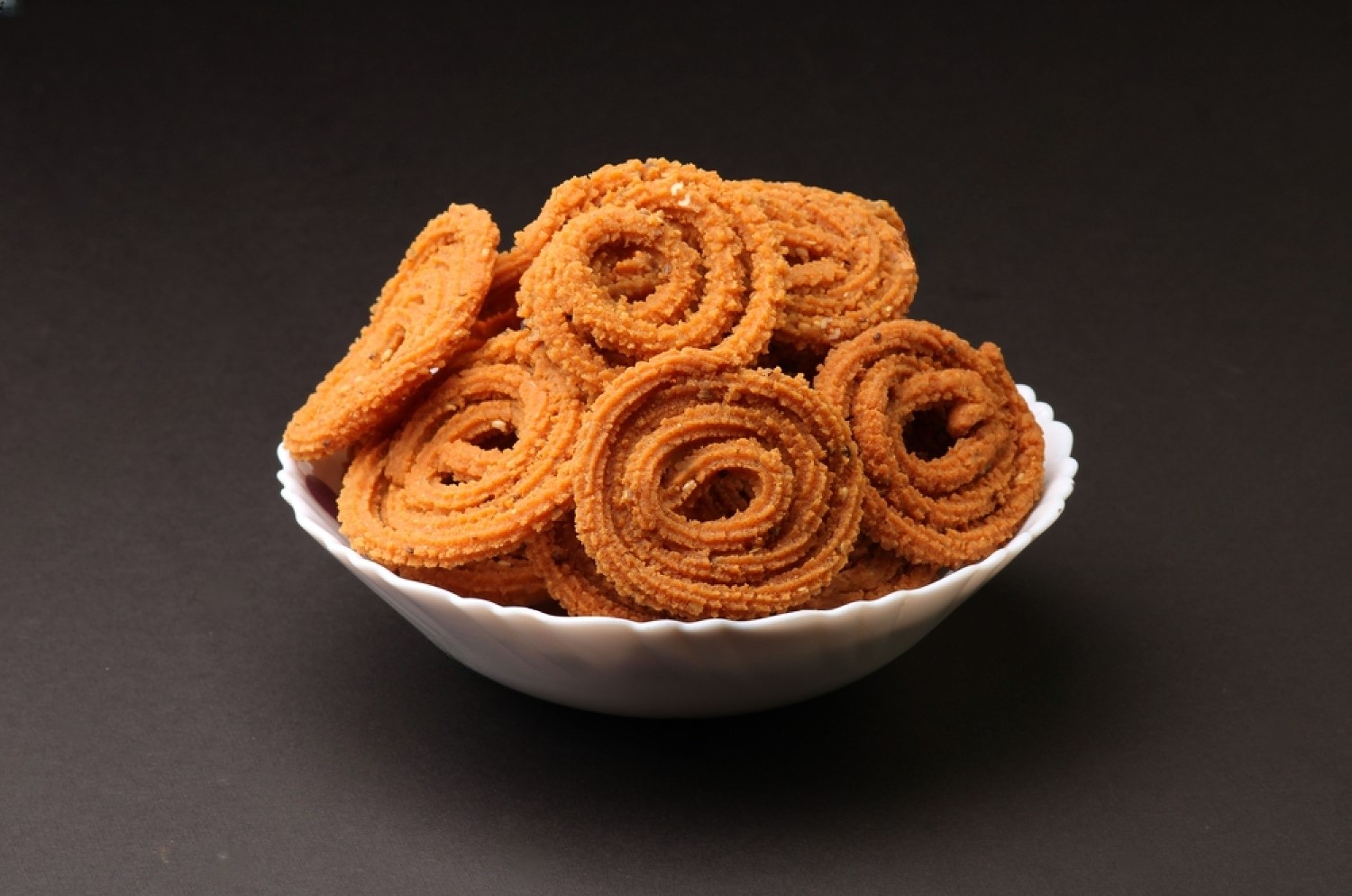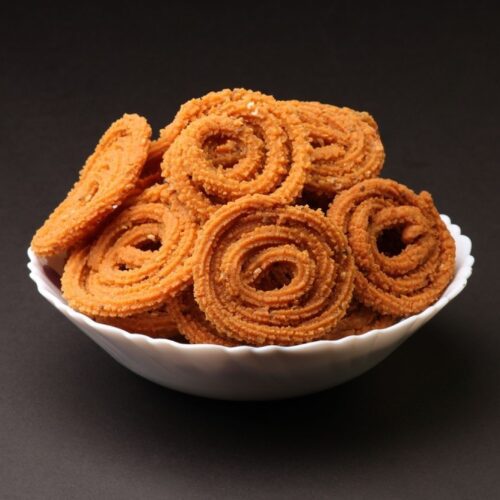Crispy Murukku (Chakali) Recipe : A Crunchy Delight

Introduction to Murukku (Chakli) – A popular Indian snack
Murukku, also known as Chakli, is a delightful and crispy Indian snack that has gained immense popularity both within India and around the world. This savory treat is made from a combination of flours, spices, and other ingredients, resulting in a unique spiral or coil-shaped snack. Murukku holds a special place in Indian cuisine, often served during festivals, celebrations, or simply enjoyed as an everyday snack. In this article, we will delve into the art of making Murukku, exploring its history, ingredients, step-by-step preparation guide, variations, serving suggestions, and storage tips. Get ready to embark on a culinary journey as we unravel the secrets of crafting this crispy and flavorful Indian delicacy.
What is Murukku (Chakli)?
Murukku, also known as Chakli, is a beloved Indian snack that is crispy, crunchy, and oh-so-delicious. It is a savoury, spiral-shaped treat that originated in South India but has now become popular all over the country. Made with a combination of rice flour and urad dal (lentil) flour, Murukku is often enjoyed during festivals, celebrations, or simply as a tea-time snack.
History and cultural significance
Murukku has a rich history and cultural significance in India. It is believed to have originated in Tamil Nadu, with variations of the snack being prepared for special occasions and religious festivals. The spiral shape of Murukku is said to represent the cycle of life and is often associated with good luck and prosperity. Today, Murukku is not only popular in India but has also gained recognition as an international snack, loved by people from different cultures.

Murukku Recipe
Ingredients
For the Murukku Dough:
- 2 cups rice flour
- urad dal (split black gram) flour
- 2 tbsp Besan (gram flour)
- 2 tbsp melted butter or ghee
- cumin seeds
- 1 tbsp sesame seeds
- A pinch of asafoetida (hing)
- 1/2 red chili powder (adjust to taste)
- Salt to taste
- Water, as needed
For Frying:
- Vegetable oil for deep frying
Instructions
Preparing the Murukku Dough:
- In a mixing bowl, combine the rice flour, urad dal flour, besan, cumin seeds, sesame seeds, asafoetida, red chili powder, and salt. Mix well to ensure even distribution of spices.
- Add the melted butter or ghee to the dry mixture and mix it in. The fat will help make the murukku crispy.
- Gradually add water little by little and knead the dough. The dough should be smooth and pliable, but not too soft or too hard. It should hold its shape when pressed.
Preparing the Murukku Press:
- Take the murukku press and choose a plate with the desired design. Make sure the press is clean and dry.
- Fill the murukku press with the prepared dough. Don't overfill it; you should be able to comfortably close the press.
Shaping and Frying the Murukku:
- Heat vegetable oil in a deep frying pan over medium heat. To check if the oil is hot enough, drop a small piece of dough into the oil; if it sizzles and rises to the surface, the oil is ready.
- Press the murukku maker directly over the hot oil in a circular or spiral pattern. You can make them as long or short as you prefer. Make sure not to overcrowd the pan.
- Fry the murukku on medium heat, turning occasionally until they turn golden brown and become crispy. This may take 5-7 minutes per batch.
- Use a slotted spoon or skimmer to remove the fried murukku from the oil and place them on paper towels to drain excess oil.
Serving and Storing:
- Let the murukku cool completely before storing them in an airtight container. They can be stored for several weeks if they are not exposed to moisture.
- Enjoy your homemade murukku as a snack with tea, coffee, or as an accompaniment to your meals.
Notes
Tips and tricks for perfect Murukku (Chakli)
Choosing the right flour
Using good quality rice flour and urad dal flour is essential for achieving the perfect texture and taste of Murukku. Look for flours specifically labeled for making Murukku or use homemade flours for better results.
Proper consistency of the dough
The dough should be neither too dry nor too sticky. Adjust the water quantity accordingly to achieve a smooth and pliable dough. If the dough is too sticky, add a little more rice flour. If it’s too dry, sprinkle some water.
Temperature and frying techniques
Maintaining the right oil temperature while frying is crucial. The oil should be hot enough to ensure the Murukku cooks evenly, but not too hot that it burns quickly. Test the oil temperature by dropping a small piece of dough into the oil. It should sizzle and rise to the surface gradually. Also, avoid overcrowding the pan while frying to prevent the Murukku from sticking together.
Now that you have mastered the art of making Murukku, enjoy this irresistible snack with your loved ones or share it at your next gathering. Happy Murukku-making!
Conclusion and final thoughts on making Murukku (Chakli)
Mastering the art of making Murukku (Chakli) opens doors to a world of flavors and textures that can be enjoyed by all. From its humble beginnings as a traditional Indian snack to its present-day variations and creative twists, Murukku continues to captivate taste buds and bring joy to countless individuals. Whether you choose to follow the classic recipe or experiment with innovative flavors, the process of making Murukku is a delightful experience that can be shared with loved ones. So, roll up your sleeves, gather your ingredients, and embark on a culinary adventure as you create this crispy, savory snack that truly embodies the essence of Indian cuisine. Happy Murukku making!
FAQ
1. Is chakli and murukku the same?
Chakli and murukku are essentially the same snack, just known by different names in different regions of India. They are both made from a mixture of rice and urad dal flours, with variations in spices and seasonings. The names might vary, but the preparation method and the enjoyment of these crispy delights are consistent throughout South India.
2. Which oil is good for murukku?
The ideal oil for frying murukku should have a high smoke point to prevent the oil from breaking down or developing unpleasant flavors during the frying process. Commonly used oils include peanut oil, vegetable oil, and sunflower oil. These oils are neutral in flavor and can maintain their stability at high temperatures, making them suitable for deep frying murukku.
3. Which state is famous for chakli?
Chakli is particularly famous in the state of Maharashtra. It is a traditional snack prepared during festive occasions, with Diwali being a prominent festival where chakli is prepared in many households. While Maharashtra is well-known for chakli, it is also enjoyed in other states of India and has regional variations in taste and preparation.
4. Is Murukku a junk food?
Murukku, like many deep-fried snacks, is calorie-dense and typically lacks essential nutrients. While it may not fall under the category of “junk food” in the way fast food does, it is still a less healthy snack option due to its high oil content. It’s best enjoyed in moderation as an occasional treat, especially during special occasions and festivals.
